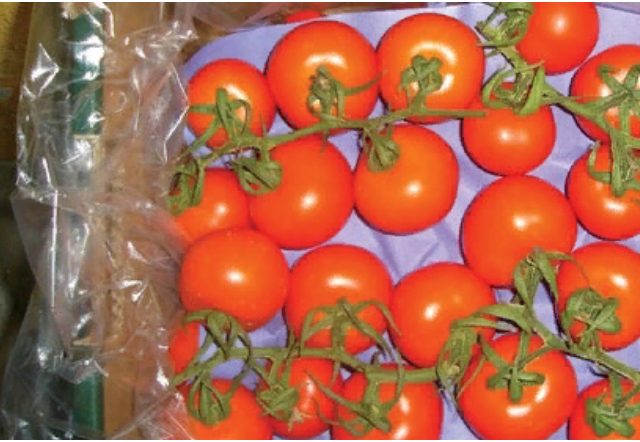The goal: extended shelf life of fresh-cut produce.
The enemy: ethylene gas produced by ripening fruit and vegetables that causes spoilage and decay. The solutions: better packaging methods and new
ways to control the atmosphere in the container.
Controlling atmosphere
Controlling atmosphere first plays out on a larger stage. Controlled atmosphere (CA) storage of apples is commonplace in large rooms containing thousands of bushels of fruit. For other crops, such as tomatoes, ripening and ethylene release is also controlled in large rooms. However, the problem of extending shelf life from processing plant to grocery store to kitchen table — especially after the produce is cut — remains.
MAP (modified atmosphere packaging) reduces the controllable space from a big room, or even a large bag, to a small container.
“Modified atmosphere was only available in bulk, big bags or big pallet covers,” said Joe Bradford, manager of produce packaging for Temkin International. “Now it’s completely different. We are now controlling any variety of packaging that can be hermetically sealed.”
Containers as systems
Achieving longer shelf life means paying attention to the atmosphere inside the container and the container itself, viewing them as a system.
“It is difficult to change the atmosphere inside a package without taking into account the permeability of the package, which can result in tradeoffs when it comes to ease of merchandising or product quality,” said Ian Ferguson, vice president of Chantler Packaging.
For the last six years, Temkin has been involved in MAP in partnership with Windham Packaging and its chief scientist, Elizabeth Marston. She works with Temkin customers to develop levels of oxygen and carbon dioxide inside the package that is specific to the fruit or vegetable, its origin and its destination.
“If one person is packing out a pound of fresh green beans in Guatemala at a temperature of 50 degrees, and another is packing in Pompano Beach at 55 degrees and another in Salinas at 46 degrees, their needs will be slightly different,” said Bradford. “We can tailor (the atmosphere) not only to the commodity, but also to the customer.”
Using microperforation technology, the desired amounts of oxygen and carbon dioxide are transferred into each hermetically sealed container through tiny openings. This slows respiration and extends shelf life.
With proper process control, shelf life can be extended weeks instead of days — sometimes from 14 to 21 or even 28 days, said Bradford.
DeltaTRAK, in partnership with Chantler Packaging, has developed a system called PrimePro Ethylene Adsorption Packaging (EAP). This system incorporates additives directly into the plastic films used for covering pallets or for lining boxes of produce.
“Our technology is unique in that we focus on controlling levels of ethylene gas, not altering the level of oxygen or carbon dioxide,” said Ferguson. “This enables our technology to work in applications that would be unsuitable for traditional modified atmosphere packaging.”
At Multivac, the company’s packaging solutions are designed to extend shelf life of prepared salads and salad kits, said Bill Williams, product manager for Mulivac’s tray sealed product line.
The T 300 inline tray sealer creates a package that is “a tray within a tray, with one seal at the top,” said Williams.
Each type of salad has its own combinations of gases that are flushed back into the package to create a specific modified atmosphere.
Another advantage to the system, and one that contributes to extending shelf life of produce, is the ease of cleaning the T 300, said Williams.
“The fresh-cut folks are concerned, and rightfully so, with hygienics: cleaning and washdown of the equipment,” he said. “The machine is extremely clean … and built to be completely washed down.”
Other Multivac options designed to extend shelf life include high-pressure preservation (HPP), used to destroy spoilage microorganisms; and the Fresh-SAFE
packaging system for fresh produce, which uses MAP and equilibrium modified atmosphere packaging drawing on microperforated film.
